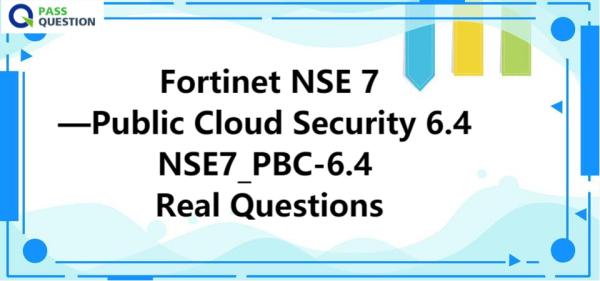Fortinet NSE 7—Public Cloud Security 6.4 NSE7_PBC-6.4 Real Questions
If you want to become a Fortinet NSE 7 Network Security Architect certified, then you should look for the best Fortinet NSE 7—Public Cloud Security 6.4 NSE7_PBC-6.4 Real Questions for the preparation of the real Fortinet NSE7_PBC-6.4 exam.After using NSE7_PBC-6.4 Real Questions created by certified professionals, you will be able to clear Fortinet NSE 7—Public Cloud Security 6.4 NSE7_PBC-6.4 exam on your first attempt.Make sure that you are using all of our NSE7_PBC-6.4 questions and answers various times so you can ensure your success when attempting Fortinet NSE7_PBC-6.4 exam.

Fortinet NSE 7—Public Cloud Security 6.4 Exam
The Fortinet NSE 7—Public Cloud Security 6.4 exam is part of the NSE 7 Network Security Architect program, and recognizes the successful candidate’s knowledge and expertise with Fortinet solutions in public cloud network environments. The exam tests applied knowledge of the integration and administration of Fortinet public cloud security solutions, and includes design scenarios, configuration extracts, and troubleshooting captures.
The Fortinet NSE 7—Public Cloud Security 6.4 exam is intended for network and security professionals who are responsible for the integration and administration of an enterprise public cloud security infrastructure composed of multiple Fortinet solutions.
NSE7_PBC-6.4 Exam Information
Exam name: Fortinet NSE 7— Public Cloud Security 6.4
Exam series: NSE7_PBC-6.4
Time allowed: 60 minutes
Exam questions: 30 multiple-choice questions
Scoring: Pass or fail, a score report is available from your Pearson VUE account
Language: English and Japanese
Product version: FortiGate 6.4,FortiWeb 6.4
NSE7_PBC-6.4 Exam Topics
Fortinet Solution for Amazon Web Services (AWS)
Identify Fortinet WAF solutions for AWS
Review AWS basic concepts and componets
Configure high availability (HA), load balancing, and autoscaling
Identify traffic patterns, MPLS, IPsec, Direct Connect
Secure the public cloud
Apply auto scaling, resilience / availability, transit VPCs, load balancing
Implement marketplace deployment, templates, sizing, automation
Apply FortiGate AWS SDN integration
Choose Fortinet products licensing in AWS Marketplace: PAYG, BYOL
Fortinet Solution for Microsoft Azure
Identify Azure Security Center, Azure Stack
Identify traffic patterns, MPLS, IPsec, ExpressRoute, Traffic Manager
Configure resilience / availability, Transit VNet, load balancing, east-west inspection
Configure HA, load balancing, and autoscaling
Choose Fortinet products licensing in Azure Marketplace: PAYG, BYOL
Implement marketplace deployment, templates, sizing, automation
Fortinet Solution for Google Cloud Platform (GCP)
Deploy FortiGate in GCP
Identify traffic patterns, MPLS, IPsec, and dedicated interconnection
Perform installation, sizing, and licensing: BYOL
FortiCASB and FortiCWP
Review FortiCASB architecture and supported applications
Review FortiCWP architecture
Configure FortiCASB
View Online Fortinet NSE 7—Public Cloud Security 6.4 NSE7_PBC-6.4 Free Questions
When configuring the FortiCASB policy, which three configuration options are available? (Choose three.)
A. Intrusion prevention policies
B. Threat protection policies
C. Data loss prevention policies
D. Compliance policies
E. Antivirus policies
Answer: BCD
You are deploying Amazon Web Services (AWS) GuardDuty to monitor malicious or unauthorized behaviors related to AWS resources. You will also use the Fortinet aws-lambda-guardduty script to translate feeds from AWS GuardDuty findings into a list of malicious IP addresses. FortiGate can then consume this list as an external threat feed.
Which Amazon AWS services must you subscribe to in order to use this feature?
A. GuardDuty, CloudWatch, S3, Inspector, WAF, and Shield.
B. GuardDuty, CloudWatch, S3, and DynamoDB.
C. Inspector, Shield, GuardDuty, S3, and DynamoDB.
D. WAF, Shield, GuardDuty, S3, and DynamoDB.
Answer: A
Which two statements about the Amazon Cloud Services (AWS) network access control lists (ACLs) are true? (Choose two.)
A. Network ACLs are stateless, and inbound and outbound rules are used for traffic filtering.
B. Network ACLs are stateful, and inbound and outbound rules are used for traffic filtering.
C. Network ACLs must be manually applied to virtual network interfaces.
D. Network ACLs support allow rules and deny rules.
Answer: AD
When an organization deploys a FortiGate-VM in a high availability (HA) (active/active) architecture in Microsoft Azure, they need to determine the default timeout values of the load balancer probes.
In the event of failure, how long will Azure take to mark a FortiGate-VM as unhealthy, considering the default timeout values?
A. Less than 10 seconds
B. 30 seconds
C. 20 seconds
D. 16 seconds
Answer: B
Which three properties are configurable Microsoft Azure network security group rule settings? (Choose three.)
A. Action
B. Sequence number
C. Source and destination IP ranges
D. Destination port ranges
E. Source port ranges
Answer: ADE
- TOP 50 Exam Questions
-
Exam
All copyrights reserved 2025 PassQuestion NETWORK CO.,LIMITED. All Rights Reserved.

